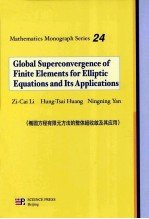
- 作 者:李子才,黄宏财,严宁宁著
- 出 版 社:北京:科学出版社
- 出版年份:2011
- ISBN:9787030334794
- 标注页数:324 页
- PDF页数:341 页
请阅读订购服务说明与试读!
订购服务说明
1、本站所有的书默认都是PDF格式,该格式图书只能阅读和打印,不能再次编辑。
2、除分上下册或者多册的情况下,一般PDF页数一定要大于标注页数才建议下单购买。【本资源341 ≥324页】
图书下载及付费说明
1、所有的电子图书为PDF格式,支持电脑、手机、平板等各类电子设备阅读;可以任意拷贝文件到不同的阅读设备里进行阅读。
2、电子图书在提交订单后一般半小时内处理完成,最晚48小时内处理完成。(非工作日购买会延迟)
3、所有的电子图书都是原书直接扫描方式制作而成。
Chapter 1 Basic Approaches 1
1.1 Introduction 1
1.2 Simplified Hybrid Combined Methods 3
1.3 Basic Theorem for Global Superconvergence 6
1.4 Bilinear Elements 8
1.5 Numerical Experiments 12
1.6 Concluding Remarks 15
Chapter 2 Adini's Elements 17
2.1 Introduction 17
2.2 Adini's Elements 19
2.3 Global Superconvergence 22
2.3.1 New error estimates 22
2.3.2 A posteriori interpolant formulas 25
2.4 Proof of Theorem 2.3.1 32
2.4.1 Preliminary lemmas 32
2.4.2 Main proof of Theorem 2.3.1 39
2.5 Stability Analysis 40
2.6 New Stability Analysis via Effective Condition Number 41
2.6.1 Computational formulas 42
2.6.2 Bounds of effective condition number 44
2.7 Numerical Experiments and Concluding Remarks 48
Chapter 3 Biquadratic Lagrange Elements 55
3.1 Introduction 56
3.2 Biquadratic Lagrange Elements 57
3.3 Global Superconvergence 59
3.3.1 New error estimates 59
3.3.2 Proof of Theorem 3.3.1 67
3.3.3 Proof of Theorem 3.3.2 73
3.3.4 Error bounds for Q8 elements 73
3.4 Numerical Experiments and Discussions 74
3.4.1 Global superconvergence 75
3.4.2 Special case of h=k and fxxyy=0 77
3.4.3 Comparisons 78
3.4.4 Relation between uh and ? 80
3.5 Concluding Remarks 83
Chapter 4 Simplified Hybrid Method for Motz's Problems 85
4.1 Introduction 85
4.2 Simplified Hybrid Combined Methods 86
4.3 Lagrange Rectangular Elements 89
4.4 Adini's Elements 96
4.5 Concluding Remarks 99
Chapter 5 Finite Difference Methods for Singularity Problems 101
5.1 Introduction 101
5.2 The Shortley-Weller Difference Approximation 102
5.3 Analysis for uD h with no Error of Divergence Integration 106
5.4 Analysis for uh with Approximation of Divergence Integration 112
5.5 Numerical Verification on Reduced Convergence Rates 120
5.5.1 The model on stripe domains 120
5.5.2 The Richardson extrapolation and the least squares method 124
5.6 Concluding Remarks 128
Chapter 6 Basic Error Estimates for Biharmonic Equations 130
6.1 Introduction 130
6.2 Basic Estimates for ∫∫Ω(u-uI)xxvxxds 136
6.3 Basic Estimates for ∫∫Ω(u-uI)xyvxyds 141
6.4 New Estimates for ∫∫Ω(u-uI)xyvxyds for Uniform Rectangular Elements 147
6.5 New Estimates for ∫∫Ω(u-uI)xxvyyds 152
6.6 Main Theorem of Global Superconvergence 157
6.7 Concluding Remarks 158
Chapter 7 Stability Analysis and Superconvergence of Blending Problems 160
7.1 Introduction 160
7.2 Description of Numerical Methods 162
7.3 Stability Analysis 167
7.3.1 Optimal convergence rates and the uniform VO h-elliptic inequality 167
7.3.2 Bounds of condition number 170
7.3.3 Proof for Theorem 7.3.4 174
7.4 Global Superconvergence 179
7.5 Numerical Experiments and Other Kinds of Superconvergence 184
7.5.1 Verification of the analysis in Section 7.3 and Section 7.4 184
7.5.2 New superconvergence of average nodal solutions 188
7.5.3 Superconvergence of L∞-norm 189
7.5.4 Global superconvergence of the a posteriori interpolant solutions 190
7.6 Concluding Remarks 190
Chapter 8 Blending Problems in 3D with Periodical Boundary Conditions 192
8.1 Introduction 192
8.2 Biharmonic Equations 194
8.2.1 Description of numerical methods 194
8.2.2 Global superconvergence 197
8.3 The BPH-FEM for Blending Surfaces 201
8.4 Optimal Convergence and Numerical Stability 206
8.5 Superconvergence 207
Chapter 9 Lower Bounds of Leading Eigenvalues 212
9.1 Introduction 212
9.1.1 Bilinear element Q1 213
9.1.2 Rotated Q1 element(Qrot 1) 213
9.1.3 Extension of rotated Q1 element(EQrot 1) 214
9.1.4 Wilson's element 214
9.2 Basic Theorems 216
9.3 Bilinear Elements 219
9.4 Qrot 1 and EQrot 1 Elements 221
9.4.1 Proof of Lemma 9.4.1 225
9.4.2 Proof of Lemma 9.4.2 226
9.4.3 Proof of Lemma 9.4.3 227
9.4.4 Proof of Lemma 9.4.4 230
9.5 Wilson's Element 232
9.5.1 Proof of Lemma 9.5.1 234
9.5.2 Proof of Lemma 9.5.2 237
9.5.3 Proof of Lemma 9.5.3 and Lemma 9.5.4 238
9.6 Expansions for Eigenfunctions 239
9.7 Numerical Experiments 241
9.7.1 Function ρ=1 242
9.7.2 Function ρ≠0 248
9.7.3 Numerical conclusions 251
Chapter 10 Eigenvalue Problems with Periodical Boundary Conditions 253
10.1 Introduction 253
10.2 Periodic Boundary Conditions 256
10 3 Adini's Elements for Eigenvalue Problems 258
10 4 Error Analysis for Poisson's Equation 260
10.5 Superconvergence for Eigenvalue Problems 263
10.6 Applications to Other Kinds of FEMs 265
10.6.1 Bi-quadratic Lagrange elements 265
10.6.2 Triangular elements 266
10.7 Numerical Results 267
10.8 Concluding Remarks 273
Chapter 11 Semilinear Problems 274
11.1 Introduction 274
11.2 Parameter-Dependent Semilinear Problems 276
11.3 Basic Theorems for Superconvergence of FEMs 279
11.4 Superconvergence of Bi-p(≥2)-Lagrange Elements 286
11.5 A Continuation Algorithm Using Adini's Elements 294
11.6 Conclusions 296
Chapter 12 Epilogue 297
12.1 Basic Framework of Global Superconvergence 297
12.2 Some Results on Integral Identity Analysis 300
12.3 Some Results on Global Superconvergence 302
Bibliography 306
Index 320
